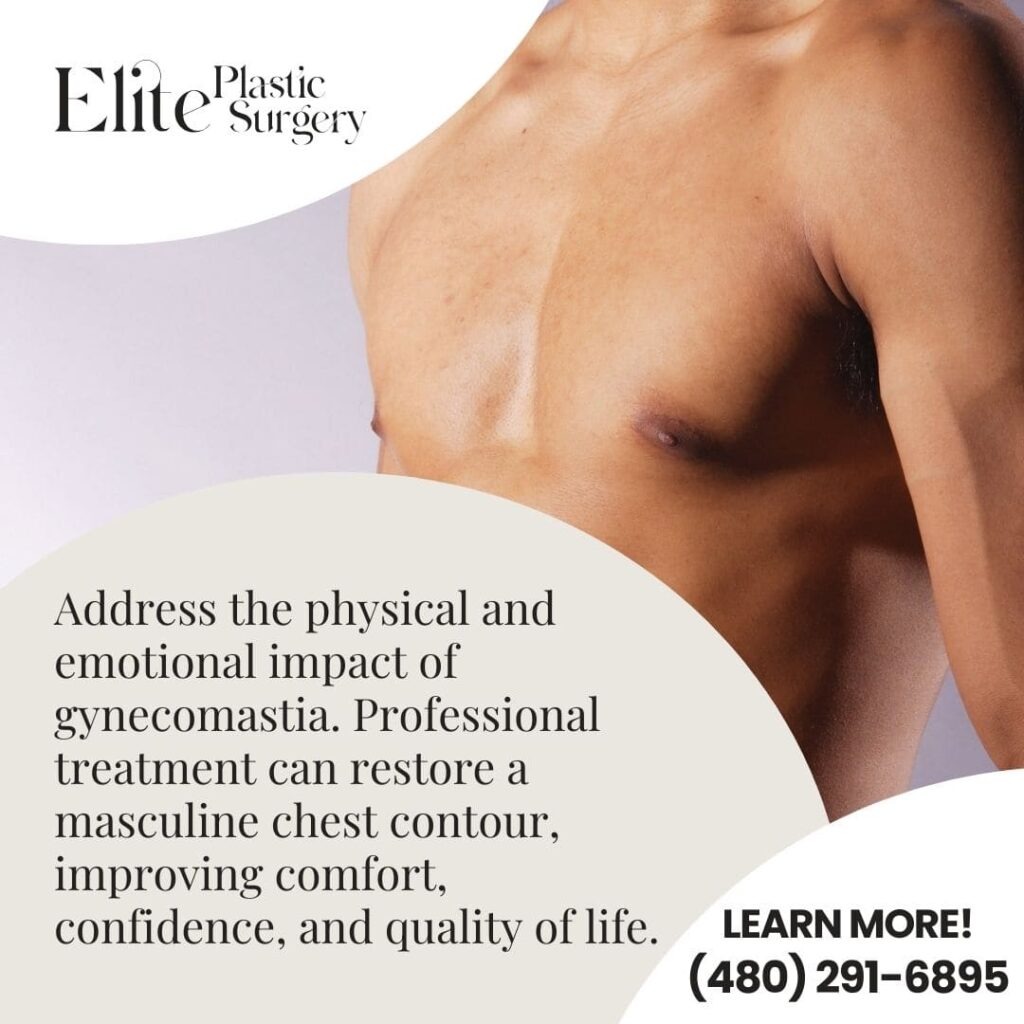Synopsis:
Gynecomastia affects up to 60% of men, yet many remain unaware of effective solutions. Discover causes, gynecomastia stages, and treatment options, including surgical gynecomastia operations, at Elite Plastic Surgery in Chandler. Reclaim your confidence with our skilled and compassionate care tailored to your needs.
Gynecomastia affects 40-60% of men during their lifetime, yet many suffer silently without knowing that effective treatment options exist. This medical condition involves the enlargement of male breast tissue, creating feminine chest contours that can devastate self-confidence and quality of life. Unlike chest fat that responds to diet and exercise, gynecomastia requires professional medical intervention to achieve meaningful improvement.
At Elite Plastic Surgery Chandler, AZ, we help men throughout Arizona understand and overcome gynecomastia through personalized treatment approaches. Our board-certified plastic surgeons, Dr. Rozbeh and Dr. Radbeh Torabi, have extensive experience addressing this sensitive condition with compassion and expertise. Whether you’re dealing with mild tissue enlargement or advanced gynecomastia stages, recognizing the condition and its impact represents your first step toward restoration.
Men experiencing gynecomastia often struggle with clothing choices, avoid physical activities, and experience relationship challenges. Understanding what causes gynecomastia, recognizing different stages, and knowing when to seek professional help can transform both your appearance and emotional well-being.

What Can Cause Gynecomastia in Men?
Hormonal imbalance between testosterone and estrogen represents the primary cause of gynecomastia across all age groups. While men naturally produce small amounts of estrogen, problems develop when estrogen levels increase relative to testosterone or when testosterone production declines significantly.
Natural Hormonal Changes
Three life stages show peak gynecomastia occurrence: infancy, adolescence, and older adulthood. Pubertal gynecomastia affects up to 65% of teenage boys due to temporary hormone fluctuations. Most cases resolve naturally within two years, though some persist into adulthood.
Age-related testosterone decline in men over 50 creates another vulnerable period. As testosterone decreases, fat tissue converts more testosterone to estrogen. This creates the hormonal imbalance that triggers breast tissue growth.
Medications That Trigger Gynecomastia
Many common medications can cause gynecomastia by disrupting normal hormone levels:
Heart medications, including spironolactone, digoxin, and calcium channel blockers, alter hormone balance and stimulate breast tissue growth.
Psychiatric medications such as antidepressants, anti-anxiety drugs, and antipsychotic medications affect hormone production as a side effect.
Prostate treatments significantly impact testosterone levels, often leading to gynecomastia development in men undergoing prostate cancer therapy.
Stomach medications like cimetidine and ranitidine have been linked to gynecomastia, particularly with long-term use.
Lifestyle and Health Factors
Several controllable factors contribute to gynecomastia development:
Alcohol consumption disrupts liver function and hormone metabolism. The liver processes hormones, and chronic alcohol use leads to estrogen accumulation.
Recreational drugs, including marijuana and anabolic steroids, create severe hormonal disruption. Steroid abuse is particularly problematic because excess testosterone converts to estrogen.
Obesity increases estrogen production through fat tissue while potentially decreasing testosterone levels, making gynecomastia more noticeable and harder to treat.
Medical conditions affecting hormone production include hyperthyroidism, kidney disease, liver disease, and tumors of hormone-producing glands.
Understanding Gynecomastia Stages
Medical professionals classify gynecomastia into four distinct stages based on tissue amount and skin excess, which directly influences treatment recommendations and expected outcomes.
Grade I: Minimal Enlargement
Grade I gynecomastia involves small amounts of firm tissue concentrated around the nipple and areola. Men typically maintain good skin elasticity and may only notice the condition during physical examination or in certain lighting. Clothing usually conceals Grade I gynecomastia effectively.
Treatment often involves liposuction alone or minimal tissue removal through small incisions. The limited tissue involvement and good skin quality allow for positive results with minimal scarring.
Grade II: Moderate Development
Grade II extends beyond the areolar region with moderate tissue enlargement. Men notice obvious chest protrusion in fitted clothing when viewed from the side. Some skin looseness may develop, though overall skin quality remains good.
This stage requires a combination treatment using both liposuction and surgical tissue removal. The extent depends on the amount of glandular tissue and the desired final contour.
Grade III: Significant Enlargement
Grade III involves substantial breast development with noticeable excess skin resembling female breast appearance. Men experience significant psychological distress as the condition becomes obviously feminine and impacts clothing choices and social interactions.
Gynecomastia treatment at this stage requires more involved surgical approaches, including tissue removal, skin excision, and possible nipple repositioning to create masculine chest contours.
Grade IV: Severe Development
Grade IV represents the most advanced form with substantial enlargement and significant excess skin closely resembling female breasts. This stage creates a profound psychological impact and severely affects the quality of life.
Treatment involves the most thorough surgical approach, often requiring staged procedures with extensive tissue removal, skin excision, and nipple repositioning.
Psychological Impact on Men
The emotional effects of gynecomastia often exceed the physical challenges, creating lasting impacts on self-image, relationships, and daily activities. Men with enlarged breast tissue frequently experience decreased confidence, social anxiety, and behavioral changes that significantly reduce quality of life.
Self-Image and Relationship Effects
Gynecomastia changes how men perceive themselves and believe others see them. Fitted shirts, athletic wear, and shirt removal situations become sources of anxiety. Many men report avoiding intimate moments or becoming preoccupied with concealing their chest during physical closeness.
Professional situations may suffer as men decline opportunities involving travel, swimming, or team activities that could expose their condition. This avoidance can limit career advancement and social connections.
Activity Limitations
Physical activity participation often decreases as men avoid situations requiring shirt removal or form-fitting athletic wear. Swimming becomes particularly challenging, and gym attendance may decline due to locker room concerns.
Reduced physical activity creates a negative cycle where decreased exercise leads to weight gain, potentially worsening gynecomastia appearance and increasing psychological distress.
Mental Health Concerns
Research shows men with gynecomastia experience higher depression and anxiety rates compared to the general male population. Constant appearance worry, fear of judgment, and activity limitations contribute to clinical depression in some patients.
Social withdrawal becomes common with severe cases as men avoid beach trips, sports activities, and social gatherings, leading to isolation and relationship strain.
When Professional Evaluation Becomes Important
Seeking professional assessment is recommended when gynecomastia persists beyond adolescence, develops suddenly in adulthood, or significantly impacts daily life and self-confidence.
Persistent Teenage Cases
While pubertal gynecomastia commonly resolves naturally, cases persisting beyond age 18-20 rarely improve without intervention. Early professional evaluation prevents years of psychological distress and social limitations, while treatment outcomes tend to be more favorable in younger patients.
Adult-Onset Development
Men developing gynecomastia in adulthood should seek prompt evaluation to identify underlying causes. Sudden breast tissue development may indicate medication side effects, hormonal imbalances, or serious medical conditions requiring immediate attention.
Gradual adult-onset gynecomastia also warrants evaluation, especially when impacting daily activities, relationships, or self-confidence.
Modern Gynecomastia Treatment Options
Current treatment approaches provide effective solutions for all gynecomastia stages, from lifestyle modifications for mild cases to advanced surgical techniques for severe conditions.
Non-Surgical Approaches
Recent-onset or mild gynecomastia may respond to non-surgical treatment. Weight loss, regular exercise, and avoiding hormone-disrupting substances help some patients achieve improvement.
Medical therapy works best for recent-onset cases with identifiable hormonal imbalances. Medications blocking estrogen effects or supporting testosterone production can reduce tissue size, though results vary significantly.
Surgical Solutions
Most established gynecomastia cases require surgical treatment for optimal results. Modern techniques provide positive outcomes with minimal scarring and reasonable recovery periods.
Liposuction works effectively for patients with primarily fatty tissue and good skin elasticity. Advanced methods allow precise contouring while preserving natural anatomy.
Tissue excision removes glandular breast tissue that liposuction cannot address. Skilled plastic surgeons like ours use precise techniques to create natural, masculine contours.
Combination procedures utilizing both liposuction and excision provide optimal results for most patients by addressing different tissue types simultaneously.
Elite Plastic Surgery’s Gynecomastia Approach
We understand that gynecomastia affects each man uniquely, requiring personalized evaluation and customized treatment plans. Our approach combines medical expertise with sensitivity to the emotional aspects of this condition.
Our Evaluation Process
Every consultation begins with a thorough medical history review, physical examination, and a detailed discussion of your concerns and goals. We identify underlying causes, determine appropriate stage classification, and assess factors influencing treatment recommendations.
Our detailed evaluation helps us recommend the most suitable treatment options for your specific situation. We explain your condition clearly, discuss realistic expectations, and answer all questions before making treatment recommendations.
Treatment Philosophy
Dr Rozbeh Torabi and Dr. Radbeh Torabi utilize current gynecomastia operation techniques, including advanced liposuction methods and precise tissue excision approaches tailored to individual anatomy. We focus on creating natural, masculine chest contours while minimizing scarring and recovery time.
Treatment options include liposuction for mild cases, tissue excision for glandular enlargement, and combination procedures for optimal results. Our commitment extends beyond surgical technique to include thorough preparation, detailed post-operative care, and long-term follow-up.
Patient-Centered Care
We recognize that gynecomastia affects more than physical appearance. Our team provides compassionate care addressing both physical and emotional aspects of your condition. We create a comfortable, private environment for open discussion and provide support throughout your treatment journey.

Recovery and Results
Recovery varies based on surgical technique and the extent of tissue removal. Most patients experience manageable discomfort for several days, controlled with prescribed medication. Swelling and bruising peak within 48-72 hours before gradually improving.
Work resumption typically occurs within one week, though physical activities remain limited for several weeks. Compression garments support healing by minimizing swelling and providing chest support during recovery.
Final results become apparent as swelling resolves over several months. Most men notice significant chest appearance improvement within weeks, with continued refinement over subsequent months.
Regain Your Confidence with Gynecomastia Treatment at Elite Plastic Surgery in Chandler
Understanding gynecomastia empowers you to take control of your confidence and quality of life. If enlarged breast tissue affects your daily activities, relationships, or self-image, effective treatment options can restore a masculine chest appearance and help you feel confident again.
Elite Plastic Surgery helps men throughout Arizona overcome gynecomastia through surgical care and personalized solutions. Our board-certified surgeons provide the expertise and compassion needed for positive results while addressing the emotional challenges this condition creates.
Do you want to explore your gynecomastia treatment options in Chandler, AZ? Contact Elite Plastic Surgery at (480) 291-6895 or [email protected] to schedule your confidential consultation. We’ll provide a detailed evaluation, explain your condition, and discuss personalized treatment approaches designed for your specific needs and goals.
We serve patients throughout Chandler, Phoenix, Scottsdale, Gilbert, Mesa, and surrounding Arizona communities. Don’t let gynecomastia continue limiting your confidence and activities. Take the first step toward the masculine chest contours you deserve today with gynecomastia treatment from our skilled plastic surgeons.